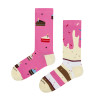Chocolate socks
The chocolate market is worth approximately 103 billion dollars and the world consumes about 7.7 million tons of chocolate sweets every year. With such numbers it is difficult to discuss whether chocolate is popular as its position seems to be getting stronger every year. April marks World Chocolate Day, so it is a perfect month to learn more about the history of this unusual treat. Socks with cake or socks with ice cream are the perfect inspiration to learn about the beginnings of chocolate treats. In the following text you will learn, among other things, when chocolate arrived in Europe, but now it is time for a short history of a box of chocolates. It is a form of chocolates that hardly anyone can resist. The name comes from the French word bonbon, meaning candy. A box of chocolates is an elegant box which hides exquisite sweets inside. In the best chocolatiers each chocolate is a result of hand work of true artists of taste. But who was the first to come up with the idea of creating a box of chocolates? In most sources Richard Cadbury is given as the creator. The first boxes of sweets were decorated with an oleo-print portrait of the Englishman's six-year-old daughter. The sets were available for sale as early as 1868. It wasn't long before Cadbury came up with another lucrative idea. This time he designed heart-shaped boxes, which soon became a real hit. After the chocolates were eaten, the boxes were still usable and were used, among other things, to store souvenirs or letters from a loved one.
Liquid magic
A hot drink with vanilla, sugar and cinnamon had one secret ingredient, which turned out to be cocoa. It was this drink that enchanted Hernando Cortez and Spanish conquistadors, who brought cocoa beans to Europe. Initially, the Spaniards carefully concealed the recipe for hot chocolate, not wanting to share it with other European nations, but this soon proved impossible. When Anne of Austria married Louis XIII, the tradition of drinking chocolate became popular at the French court. The Spanish princess, like most people, believed that it was not only delicious but also a medicinal drink. Chocolate was supposed to, among other things, strengthen immunity and significantly increase energy levels. At the same time the custom of drinking chocolate also appeared in English and Italian courts. The exquisite delicacy was reserved primarily for people from high social strata. It took a long time for chocolate to become a widely available commodity. C.J. van Houten contributed to this development by creating a special press used to grind cocoa beans. As a result, the production of chocolate became much easier and the product was no longer reserved exclusively for wealthy people. Not only the Spanish and the Dutch but also the English and the Swiss contributed to the spread of chocolate. The first chocolate bars were produced on the British Isles and industrial production of chocolate began in Switzerland, where the milk chocolate formula was also created. In the 19th century, chocolate was already known in many parts of Europe.



